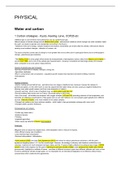Summary
Summary Case study notes - A level Human and Physical Geography
- Institution
- AQA
Detailed notes of case studies, with facts and figures, for revision and reference in exam essay questions, as well as key facts to learn from throughout the course. Covers the following modules: -Water and Carbon -Changing Places -Population and the environment -Coasts -Hazards -Global gover...
[Show more]



